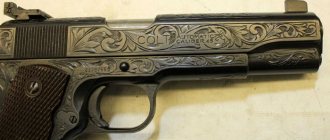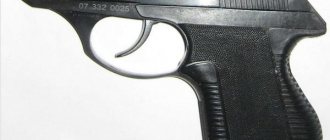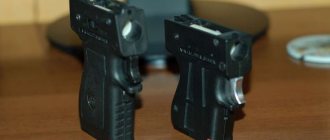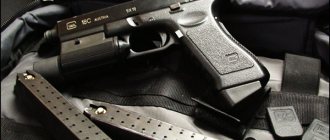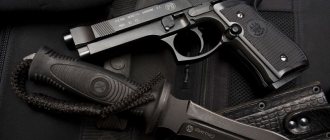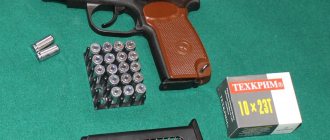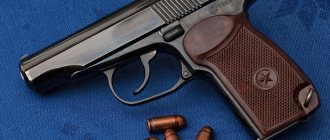Despite the developed military industry in Russia, an impressive complex for the production of weapons, the leading position in the trauma market in our country is occupied by weapons produced in other countries or made in Russia, but on the basis of foreign weapons. But few people know that, for example, in the same Ukraine, where the Groza complex, made on the basis of the Fort line, came to Russia, there is a popular traumatic pistol made on the basis of a Russian gun.
Despite the fact that Russia and Ukraine were once part of one large state, weapons legislation in the countries differs from each other, which affects the requirements for trauma.
In Russia, the main focus of legislation is to ensure that traumatic pistols do not use more powerful cartridges than those specified during certification of the gun, as well as military ammunition. In Ukraine, more stringent requirements for the power of charges are imposed, so weapons there are, in principle, more reliable. You can use powerful cartridges there without any consequences for traumatic pistols.
Another feature is that in Ukraine there are two types of barrels that are used in guns, unlike Russia, where only one design is used. So, in both countries there is a “toothed” version of the barrels, and in Ukraine there is also a “smooth” design, the peculiarity of which is its diameter: it is smaller than a bullet. An example of adapting Russian trauma weapons to the Ukrainian market can be seen in the example of the PMR pistol, which will be discussed in today’s review.
Characteristics of UMK M-45 45 Rubber LLC
The traumatic pistol was created based on the design of the famous Makarov pistol. This alone proves the wear resistance and reliability of modern weapons. Suitable for shooting are 45 Rubber cartridges; this type of cartridge is not rare and can be purchased at most gun stores.
A double-action trigger mechanism is used and a safety lock is provided. Reloading is carried out by changing the clip or alternately pushing cartridges into the chamber.
The color of the model is black or two-tone - light barrel, dark handle. The M-45 Strela model is produced by Uralmekhkomplekt LLC, Izhevsk, this is the first model of the plant. Magazine capacity - 6 rounds, weapon length - 16.2 cm, width - 3.1 cm, height 12.7 cm. Weighs 630 g. Barrel length 9.4 cm. Parts and mechanisms are made of metal and plastic. The package includes a box, a pistol, a separate magazine, and an instruction manual.
Self-defense weapon: revolver Ratnik 410×45TK
The Ratnik 410×45TK revolver is currently certified as a firearm of limited destruction
Revolver
The Ratnik 410×45TK revolver chambered for the 410×45 Rubber traumatic action cartridge was designed by the AKBS company from Nizhny Novgorod based on the design of the service large-caliber Udar revolver of the Tula Instrument Design Bureau. Unlike the previous model “Ratnik 13x45”, the new Ratnik revolver currently uses traumatic cartridges 410x45, which have the same steel sleeve as the .410 hunting cartridge, but shortened to 45 mm, and are equipped with one rubber bullet with a diameter of 16 mm and weighing about 3 g. The new traumatic revolver Ratnik has the full name “Ratnik 410×45TK”.
The main design feature of the new version of the Ratnik revolver is a smooth barrel and cylinder chambers that have no taper, no narrowing, no “teeth”, it’s just a cylinder! The drum of the rubber-fired revolver “Ratnik 410×45TK” is no longer made of duralumin, but steel. In addition, the revolver frame is reinforced with a steel plate in the area where the firing pin exits, so that it is not broken by primers. As a result, the energy, durability of weapons and their service life have increased significantly.
A firearm of limited destruction, the Ratnik 410×45TK revolver is made according to the usual revolver design with simultaneous extraction of spent cartridges using a side-folding drum. The drum tilts to the left. The drum latch is also located on the left side of the revolver frame. The revolver is loaded one cartridge at a time. Spent cartridges, or cartridges when unloaded, are extracted by pressing the head of the extractor axis. The trigger mechanism is hammer type, double action, with a semi-hidden trigger. The trigger is hidden from the sides by the walls of the revolver frame, and for cocking the hammer manually, the trigger head with a large notch partially protrudes from the top of the frame. The sights are open and not adjustable.
The Ratnik 410×45TK revolver, like the Udar service revolver, is a rather unusual weapon with an angular design that can even be described as futuristic. In general, the Ratnik 410×45TK revolver is a functional weapon, designed for the effectiveness of its intended use, and not for spectacular appearance and stylistic delights. It doesn't have the classic, charismatic design of a Smith & Wesson or Colt revolver, but it is primarily a self-defense weapon.
The disadvantages of this sample include the large width of the weapon, which is a consequence of the 44 mm wide drum, but only in the context of choice when comparing the Ratnik not only with revolvers, but also with pistols. In terms of other technical characteristics, such as length, height and weight, the Ratnik 410×45TK belongs to the medium-sized models of short-barreled weapons.
As in the case of short-barreled combat weapons, for example, the compact Glock 26 self-loading pistol and the full-size Glock 21, the buyer must decide for himself what task he needs the weapon for and how well it will meet his requirements. It makes sense to choose the most suitable holster for the Warrior, so that the revolver fits comfortably, is quickly accessible and is as inconspicuous as possible. When choosing a Ratnik 410×45TK traumatic revolver for carrying, with a well-chosen holster, the owner receives a truly effective self-defense weapon.
Traumatic revolver Ratnik 410×45TK
Currently, the Ratnik 410×45TK revolver is certified as a firearm of limited destruction.
Appearance
The weapon is similar in appearance to the Makarov pistol, on the basis of which it was developed.
In terms of size, weight and design, the Strela is not much different from the prototype. The model can be purchased by those who are accustomed to using military weapons that are suitable in type, weight and ergonomics. Also suitable for collectors who like to use weapons similar to the famous ones.
What conclusion can be drawn about PMR?
The PMR .45 Rubber pistol, the production of which began in Ukraine in 2000, is an excellent adaptation of military weapons according to the traumatic scheme. During adaptation, the main components were preserved, which ensures high reliability and a high supply of working resources.
It is possible to use more powerful cartridges specified in the weapon documentation. To do this, you simply need to replace the standard return spring with a stiffer one. After reviewing this pistol, we can safely say that the PMR .45 Rubber can be used as the main weapon for regular self-defense.
Advantages
Users note the following advantages of the Strela M-45 model: 45 caliber, which is considered popular, purchasing cartridges is not difficult. Shoots with precision, almost no recoil, fits comfortably in the hand. Users managed to appreciate the design style, simple but reliable construction, power and impact force. The quality of the materials is high, frequent cleaning is not required, and there are no problems with operation.
The body of the Strela M-45 pistol is made of stainless steel and equipped with a safety lock. The shutter has milled notches. The sight is adjustable, the handle has a rubberized surface, so the hand does not slip, and the shot is accurate. Due to its compactness and low weight, it is suitable for concealed carry, especially if you choose the right holster. Spare parts and cartridges are quite easy to purchase, which adds to the pistol’s attractiveness in the eyes of potential buyers.
"Ugly duck"
The first Ratnik model appeared in 2004. He immediately received the nickname "The Ugly Duckling" for his unsightly and angular appearance. Meanwhile, the revolver almost immediately found its admirer.
One feature that caught my eye was that its frame was made of aluminum. The developers tried to implement the idea of reducing the weight of the weapon, but this step called into question the reliability and strength of the design.
But only the frame turned out to be aluminum. The release mechanism itself, including the drum, was made of steel.
Oddities in Ratnik’s appearance appear already at the first inspection. The trigger is so hidden in the frame that only a small part of it protrudes out, which is covered with a notch designed for a convenient cocking process.
There is a practical touch to this design. Thanks to the hidden trigger, the revolver became streamlined. This quality is especially important for any self-defense weapon, since in emergency cases you will have to remove it from a holster or pocket quickly enough. The weapon should not cling to anything. The shortened barrel also looks unusual, but it adds a streamlined look to the revolver.
The Ratnik trigger is protected by a fairly large safety guard. Users note that this bracket allows you to shoot a pistol without taking off your gloves. In addition, when holding and aiming a weapon with both hands, the fingers of the second hand are conveniently located on the bracket.
Unfortunately, the paintwork on the revolver frame left much to be desired. Chips appear on it, and the paint along with the varnish peels off. A similar phenomenon occurred in almost every revolver of the “Ratnik” model.
The caliber of cartridges for this revolver is 13 mm. To be more precise, to characterize the cartridge it is also necessary to indicate its length. The first models made it possible to load five 13x45 mm cartridges into the drum. Today you can only buy cartridges with steel cases, although they were originally made of aluminum. Two bullets were placed in them. Each bullet had a mass of 2.2 g, which made it possible to develop an energy of 60 J. The diameter of each ball was 12.5 mm. In principle, such parameters were quite suitable for traumatic weapons. Although according to official data the aimed firing range was 10 meters, practice has shown that this distance is approximately two times less.
It is more convenient to evaluate the accuracy of a shot by the distance on the target between two points where the balls from the same cartridge hit. Already at a distance of 5 meters to the target, the spread reaches 15 cm. This information is especially important for the defender, since there is a possibility of hitting prohibited places (eye, temple), which can lead to tragedy.
The aiming devices that the warrior revolver has are a front sight and rear sight. Despite the designers' attempts to create them in such a way that they would not cling to clothing parts, it was not possible to disguise the protrusions. The rear sights are not adjustable, but some owners talk about the possibility of filing the grooves with a file. If we think objectively, then with relatively low rates of shooting accuracy, there is no particular point in adjusting the rear sight.
If we judge the “Ratnik” model based on owner reviews, a rather positive picture emerges. Everyone noted the oddities of the design, but almost everyone considered this revolver to be practical and reliable. It is important that after acquisition nothing needed to be corrected or remade. Not immediately, but still the model received a positive review from the mass user. If we dwell on the shortcomings, there are only a couple of objective points.
- Poor quality of coating. Many users have turned this disadvantage into an advantage, since the places where the paint has peeled off can be painted in any colors you wish.
- Protruding rear sight with offset slot. The displacement is due to compensation for the reaction when fired. Sighting devices cannot be completely veiled, so this drawback is simply impossible to get rid of.
Flaws
Among the disadvantages of the model are the relatively high cost and some difficulty in disassembling. But they fade into the background compared to the undoubted advantages of models based on Makarov.
The Strela M-45 limited destruction weapon is produced by a Russian manufacturer. It was based on the famous Makarov pistol, known to many for being reliable, trouble-free, and durable. The Strela model can be considered suitable for purchase for self-defense purposes, as well as for training shooting and amateur target shooting.
The history of the creation of the PMR traumatic pistol
The PM combat pistol, which at one time was in service with many law enforcement agencies, is very popular. He was loved for his appearance, power and reliability. That is why there is a high demand for traumatic pistols made on the basis of the combat Makarov.
However, the years when the production of traumatika began on the Ukrainian and Russian markets differ. The first examples appeared in Ukrainian many years before their appearance in Russia. The Makarov, in turn, was produced only in Russia, so in Ukraine the question arose: how to adapt a popular combat pistol for a traumatic weapon if we don’t have it in stock?
Produce from scratch? Then we would have to incur additional costs for resources, which would affect the price of traumatic pistols. In addition, then it would no longer be possible to say that this weapon adopted the high quality, history and features from the combat PM.
But the problem was quickly resolved, since in 2000, when production of the PMR pistol began, there were a lot of gas guns on the Ukrainian arms market that were made on the basis of Makarov. It was decided to adapt it for trauma.
Many experts were skeptical about the idea of converting a gas gun into a traumatic one. The fact is that everyone who was interested in weapons was aware of similar deplorable adaptations by the Umarex company, which supplied light-alloy trauma weapons to the Russian and Ukrainian markets.
The main difference between the PMR was that it was made of steel. It would seem that this should have given him a huge supply of working life, but as soon as the specialists began testing the new traumatic charges at the shooting range, they realized that the barrel, made for gas equipment, could not withstand shots from traumatic charges. That is why in the same year it was decided to arrange the supply of Makarov combat models to Ukraine in order to carry out their further adaptation to traumatic weapons and begin production for sale.

